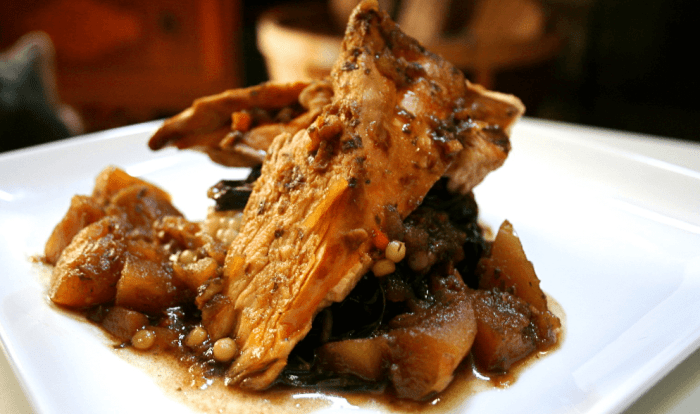
Chicken of the woods recipe – Chicken of the woods, with its vibrant orange hues and meaty texture, is a culinary treasure waiting to be discovered. This guide will take you on a journey through the identification, preparation, and delectable flavors of this wild mushroom.
From sautéing to grilling, and pickling to preserving, we’ll explore the versatile culinary applications of chicken of the woods. Along the way, we’ll uncover its unique flavor profile and delve into the cultural significance and traditional uses of this fascinating fungus.
Chicken of the Woods Identification and Safety
Chicken of the woods ( Laetiporus sulphureus) is a vibrant and edible mushroom that thrives in forests worldwide. Its striking appearance and distinct flavor have made it a sought-after delicacy among mushroom enthusiasts.
To ensure safe and enjoyable consumption, it’s crucial to accurately identify chicken of the woods and distinguish it from potentially toxic lookalikes.
Physical Characteristics
- Color:Chicken of the woods exhibits a bright orange to yellow hue, often with darker orange or red tips.
- Shape:It typically forms large, shelf-like clusters that can weigh up to 10 pounds.
- Texture:The flesh is firm and slightly spongy, with a moist consistency.
- Pores:The underside of the mushroom features small, round pores rather than gills.
- Stem:Chicken of the woods lacks a distinct stem and directly attaches to the substrate (e.g., tree trunks).
Differentiating Edible from Inedible Varieties, Chicken of the woods recipe
While chicken of the woods is generally safe to consume, it’s essential to note that some similar-looking mushrooms can be poisonous. To avoid confusion, consider the following tips:
- Color:True chicken of the woods is bright orange to yellow, while inedible lookalikes may be pale or have a greenish tinge.
- Pores:Edible chicken of the woods has small, round pores, whereas toxic species often have gills.
- Habitat:Chicken of the woods grows on dead or decaying hardwoods, especially oak trees.
- Smell:Edible chicken of the woods has a pleasant, fruity aroma, while inedible species may have a pungent or unpleasant odor.
Importance of Proper Identification
Correctly identifying chicken of the woods is crucial to prevent accidental ingestion of toxic mushrooms. Consuming poisonous mushrooms can lead to severe health complications, including gastrointestinal distress, organ damage, and even death. Therefore, it’s essential to exercise caution and consult with experienced mushroom foragers or use reliable field guides for identification.
Culinary Applications and Preparation Techniques

Chicken of the woods offers culinary versatility, lending itself to various cooking methods that enhance its unique flavor and texture. Understanding its optimal preparation techniques will unlock its full culinary potential.
Cleaning and Preparation
Cleaning chicken of the woods involves removing any dirt or debris. Cut away any tough or woody portions, especially near the base. Slice the mushroom into bite-sized pieces or strips for ease of cooking and serving.
Sautéing
Sautéing is a quick and flavorful way to prepare chicken of the woods. Heat a skillet over medium heat and add some oil. Add the mushroom pieces and cook until tender and slightly browned, about 5-7 minutes. Season with salt and pepper to taste.
Grilling
Grilling imparts a smoky flavor to chicken of the woods. Brush the mushroom pieces with oil and grill over medium heat for 10-15 minutes, turning occasionally. Baste with a marinade or sauce for added flavor.
Roasting
Roasting chicken of the woods brings out its earthy notes. Preheat the oven to 400°F (200°C). Toss the mushroom pieces with oil, salt, and pepper. Roast for 20-25 minutes, or until tender and slightly crispy.
Pickling
Pickling chicken of the woods preserves its flavor while adding a tangy twist. Slice the mushroom thinly and place it in a jar. Create a brine with vinegar, water, salt, and sugar. Pour the brine over the mushrooms and let it marinate for at least 24 hours before consuming.
Preservation and Storage
To maintain the freshness of chicken of the woods, store it in the refrigerator for up to 5 days. For longer storage, it can be dried or frozen. Drying involves slicing the mushroom thinly and dehydrating it in a dehydrator or oven at a low temperature.
Frozen chicken of the woods can be kept for several months.
Flavor Profiles and Pairing Suggestions

Chicken of the woods possesses a distinctive flavor profile that combines earthy, meaty, and slightly sweet notes. Its umami-rich taste makes it an excellent meat substitute in various culinary applications.
Complementary Ingredients and Seasonings
To enhance the flavor of chicken of the woods, consider incorporating complementary ingredients and seasonings. Herbs like thyme, rosemary, and sage add aromatic notes, while spices such as paprika, cumin, and chili powder impart warmth and depth.
Pairing Suggestions
Chicken of the woods pairs well with a range of side dishes, sauces, and beverages. Roasted vegetables, mashed potatoes, or grilled polenta complement its earthy flavor. Creamy sauces, such as mushroom or béchamel, add richness and depth. To enhance the umami notes, serve with a side of soy sauce or tamari.
For beverages, consider pairing chicken of the woods with a medium-bodied red wine or a crisp white wine. The tannins in red wine balance the umami flavors, while the acidity in white wine cuts through the richness of the dish.
Nutritional Value and Health Benefits
Chicken of the woods is a nutrient-rich fungus that offers a range of health benefits.It is an excellent source of protein, providing around 10-25% of its dry weight. Chicken of the woods is also a good source of fiber, which is essential for maintaining a healthy digestive system.
It contains both soluble and insoluble fiber, which help to regulate blood sugar levels and promote satiety.
Antioxidant Properties
Chicken of the woods is rich in antioxidants, which help to protect cells from damage caused by free radicals. Free radicals are unstable molecules that can contribute to aging, inflammation, and chronic diseases. The antioxidants in chicken of the woods include ergothioneine, a powerful antioxidant that has been shown to protect cells from oxidative stress.
Anti-inflammatory Properties
Chicken of the woods also has anti-inflammatory properties. It contains compounds that have been shown to inhibit the production of inflammatory cytokines, which are molecules that can trigger inflammation. This anti-inflammatory activity may help to reduce the risk of chronic diseases such as heart disease, cancer, and arthritis.
Cultural Significance and Traditional Uses
Chicken of the woods has played a significant role in various cultures worldwide. In many regions, it has been a traditional food source and an important ingredient in traditional medicine.
Culinary Significance
- North America:Native American tribes have long used chicken of the woods as a culinary staple. They would dry and store it for later use during winter months.
- Europe:In Eastern Europe, chicken of the woods is known as “maitake” and is highly prized for its unique flavor and texture. It is often used in soups, stews, and as a meat substitute.
- Asia:In Japan, chicken of the woods is known as “houbitsushimeji” and is considered a delicacy. It is used in tempura, miso soup, and various other dishes.
Medicinal Uses
- Traditional Chinese Medicine:Chicken of the woods has been used in traditional Chinese medicine for centuries to treat various ailments, including cancer, inflammation, and immune disorders.
- Modern Medicine:Research is ongoing to explore the potential health benefits of chicken of the woods. Studies have shown that it contains compounds with antioxidant, antibacterial, and antiviral properties.
Final Review: Chicken Of The Woods Recipe

Whether you’re a seasoned forager or a curious cook, this guide will equip you with the knowledge and inspiration to enjoy the delicious and versatile chicken of the woods.
Common Queries
What does chicken of the woods taste like?
Chicken of the woods has a unique flavor profile that is often described as earthy, meaty, and slightly sweet.
How do you prepare chicken of the woods?
Chicken of the woods can be sautéed, grilled, roasted, or pickled. It’s important to cook it thoroughly to avoid any potential health risks.
What are the health benefits of chicken of the woods?
Chicken of the woods is a good source of protein, fiber, and vitamins. It also contains antioxidants and anti-inflammatory compounds.





